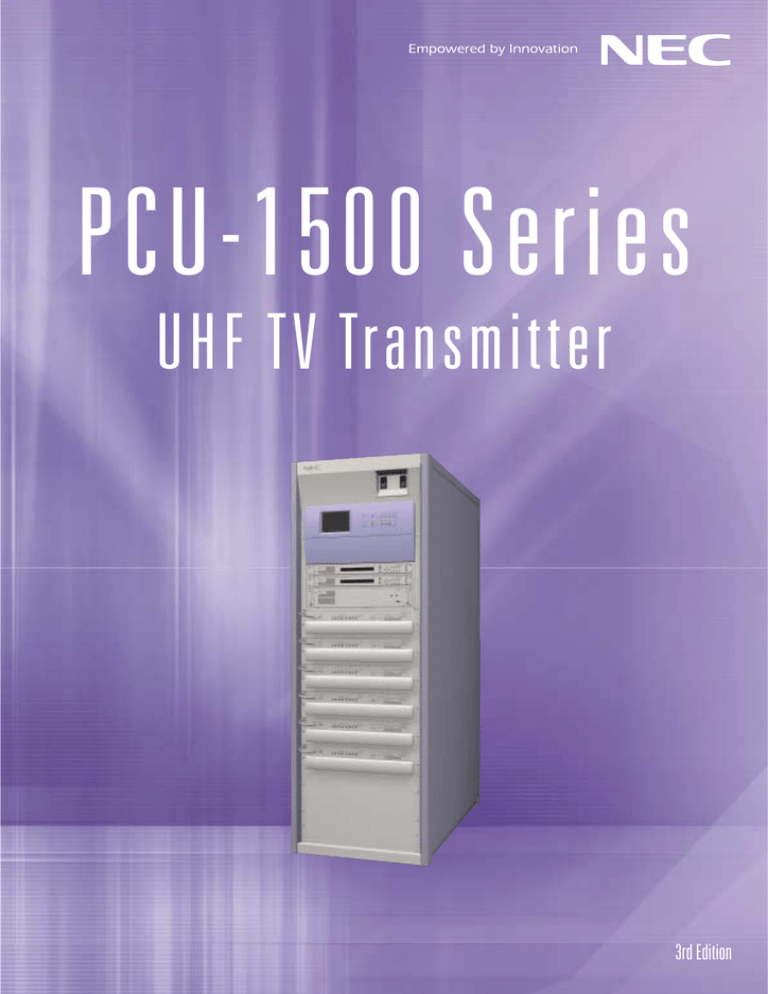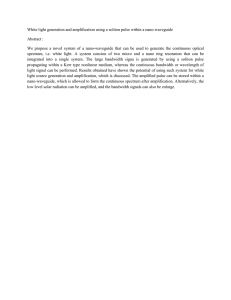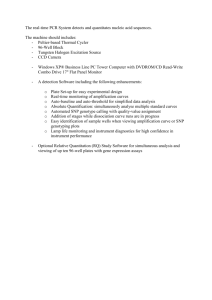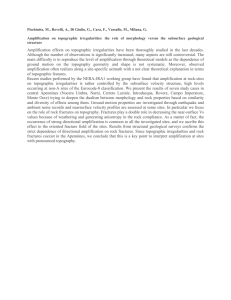PCU-1500 Series UHF TV Transmitter
advertisement

PCU-1500 Series UHF TV Transmitter 3rd Edition The Benchmark in Analog TV Broadcasting Compact design and innovative technology establish NEC’s new transmitter as the new benchmark in analog TV transmitters. Proven results NEC transmitters are renowned throughout the broadcast community for their superior reliability and minimal maintenance requirements. The new PCU series is the outcome of NEC’s vast experience in providing thousands of transmitters around the world, applying our sophisticated expertise in product design to set a new standard in ultra-compact UHF analog television transmitters. And now, by employing a new exciter, the PCU-1500 series enables easy conversion to digital TX. PCU-1500 Series Features ■ Easy conversion to digital TX After a period of simultaneous analog-digital broadcasting, analog broadcasts will be discontinued. Analog TV transmitters will then be converted to digital and utilized as auxiliary transmitters or main transmitters in order to increase the number of MUXs (multiplexers) and utilize resources more effectively. With this in mind, NEC has come up with a new digitalized exciter that enables easy conversion from analog to digital through the replacement of software in our newest transmitter series. ■ All-band solution Broadcasters are required to employ broadband-compatible transmitter units in situations that require channel change for common spare units or digital conversion. NEC’s PCU-1500 series provides an optimum solution for this requirement. Its exciter features direct modulation and a synthesizer, enabling the transmitter to be used for any UHF channel, simply by changing the frequency setting, and eliminating the need for BPF (Band Pass Filter) adjustment at the exciter stage. Its power amplifier (PA) incorporates a frequency table that automatically adjusts the gain and phase, providing an all-band solution and streamlining frequency adjustment. ■ Superior maintenance function The automatic correction function in the exciter’s compensation circuit makes it extremely easy to perform characteristics adjustment as an automatic compensation, without having to use a demodulator. The color LCD panel enables easy monitoring of transmitter operation. The warning indication facilitates optimum troubleshooting before possible transmitter malfunction, enhancing availability. ■ User-friendly monitoring The TX control unit features a built-in web server and SNMP. By connecting transmitters to a local area network, transmitters can be monitored and controlled from a remote PC with a web browser. Monitoring and control are also possible using the SNMP manager. ■ Sophisticated hybrid liquid cooling NEC’s extensive liquid cooling experience has enabled us to design a simple but highly efficient cooling method that incorporates an automatic air-purge function and ensures easy water feeding. The latest digital broadcasting technologies ■ Power Amplifier (PA) features The PCU-1500 series power amplifier employs LDMOS output devices. This compact, highly efficient broadband solid-state amplifier offers high linearity and incorporates a self-protection circuit for superior reliability. The PA features a built-in power supply that can be connected and removed, even during TX operation, to ensure prevention of leakage of liquids. ■ DM-3000B Analog Exciter features The DM-3000B analog exciter is packed with state-of-the-art NEC technology. Integrating a broad range of functions into a single unit of greatly reduced size, this exciter can be easily upgraded from analog to digital TX system. A synthesizer tuned to all UHF band signals enables all-band direct conversion to an RF output. By employing an all-band synthesizer and direct conversion, any channel can be used simply by setting the compatible frequency. Furthermore, automatic compensation can be performed at the touch of a button, without having to use a demodulator. ■ Control and monitoring system The control and monitoring system is composed of the TX control unit, an RF detector and a color LCD screen. To enhance transmitter availability, the system is divided into a unit that manages basic control and protection operations and a monitor. The monitor consists of an easy-to-view color LCD screen that enables effortless monitoring of transmitter operation and detects any possible malfunction at a glance. Log data not only displays changes in operational status, including faults, but also enables verification of related data in case of system failure, thereby streamlining analysis of abnormal status. Frequency settings can be conducted at the touch of a button on the color LCD screen. ■ Monitoring system with remote control function The TX control unit incorporates a web server and SNMP agent, enabling the transmitter to be connected to a local area network for monitoring and control of transmitter operations via a remote PC with web browser. At the same time, monitoring and control from an SNMP manager are also possible. SITE-1 • NMS (SNMP MANAGER) IP Network PCU-1500 transmitter With SNMP AGENT/WEB SERVER function SITE-2 Internet Explorer WEB Browser • WEB CLIENT ■ Liquid cooling system The PCU-1500 series transmitter features an innovative, highly efficient liquid cooling system employing a hybrid closed circuit method that provides such advantages as automatic air purging, easy coolant feeding, coolant replacement during operation and lower overall cooling costs. NEC’s liquid cooling system is based on an original adaptation of common cooling methods. It allows multiple transmitters within the same building to be handled by a single, common cooling system, providing an exceptionally cost- and energy-effective cooling solution. Fan 1 M Fan 2 M Fan 3 M Heat Exchanger Passive/Reserve (Reserve) LS TS TS Water/ Water/ Glycol glycol FM PS PA/PS Pump A PA/PS Pump B PA/PS Pump Rack (Single with Redundancy System) PA/PS Passive/Reserve Transmitter FM: Flowmeter LS: Level Switch M: Motor PS: Pressure Switch TS: Thermal Switch Configuration of PCU-1500 Series PCU-1500 Series Lineup PCU-15 1 1 2 3 / 4 5 2 : Output Power Type Number 01 02 05 10 15 20 30 4 : System Type SS: Single Transmitter with Single Drive SSP: Single Transmitter with Dual Drive and Multiple PAs SSPE: Single Transmitter with Dual Drive SSW: Dual Transmitter in Active Reserve Output Power 1kW 2kW 5kW 10kW 15kW 20kW 30kW 3 : Cooling Type : Visual/Aural Power Ratio 1➝10:1 5➝5:1 5 : Amplifier Mode Nil: Separate Amplifier C: Common Amplifier Q: Liquid Cooling System Configuration Type Separate Amplification VIA COMB EX-A n-Combiner SS TRPA n-Divider n-Divider EX-A n-Combiner V-PA Common Amplification BPF A-PA Cooling Equipment n-Combiner TRPA EX-A n-Divider n-Divider SSP n-Combiner V-PA EX-A Cooling Equipment VIA COMB BPF EX-A EX-B A-PA Cooling Equipment (with redundancy) V-PA TX-A TRPA V/A Combiner EX-A Cooling Equipment (with redundancy) EX-A TX-A BPF A-PA SSW Cooling Equipment EX-A Cooling Equipment COMB EX-A TX-B (Same as TX-A) TX-B Cooling Equipment (Same as TX-A) Cooling Equipment COMB Configuration of PCU-1500 Series PCU-1500 Series Specifications Visual 625-line ITU-R Standard-B/G Characteristics 625-line ITU-R Standard-I Type of Emission 525-line ITU-R Standard-M 625-line ITU-R Standard D/K C3F Operating Frequency Range 470MHz ~ 862MHz Carrier Frequency Stability 50Ω with VSWR ≤1.5 Load Impedance Input Level Sync. Video 0.3V ± 6dB 0.7V Input Impedance 75Ω, return loss not less than 34dB 75Ω, return loss not less than 34dB up to 4.2MHz up to 5MHz 75Ω, return loss not less than 34dB up to 5MHz AM Noise Periodic Noise (1kHZ LPF) Unweighted Continuous Random Noise Weighted Continuous Random Noise Linear Distortion Frequency vs. Amplitude Response Group Delay Transmitter without RX precorrection measured with phase linear demodulator Transmitter with RX precorrection measured with standard demodulator -50dB (p-p) or better -52dB (r.m.s.) or better -60dB (r.m.s.) or better Freq. (MHz) -4.43 -4.43 ~ -1.25 -1.25 ~ -0.75 -0.75 -0.5 0 ~ +1.5 +1.5 +1.5 ~ +4.5 +5 +5.5 Limits (dB) -30/-20/+0.5/+0.5/-4 +0.5/-1.5 +0.5/-0.5 Ref. +0.5/-0.5 +0.5/-2.5 -26/- •Common Amplification: Up to 4.8MHz: ± 50nS •Separate Amplification:Up to 4.8MHz: ± 40nS •Common Amplification: Up to 4.43MHz: ± 50nS 4.43 ~ 4.8MHz: ± 100nS except ripple caused by SAW filter •Separate Amplification: Up to 4.43MHz: ± 40nS 4.43 ~ 4.8MHz: ± 80nS except ripple caused by SAW filter Measured with a 250kHz square wave (risetime 90 nS): Time (µs) Limits (%) ± 0.075 -10 ± 0.1 +11 ± 0.2 ±7 ± (0.4 ~ 1.0) ±5 Transient Response Freq. (MHz) -3.58 -3.58 ~ -1.25 -1.25 ~ -0.75 -0.75 -0.5 0 ~ +1.5 +1.5 +1.5 ~ +3.6 +4.18 +4.75 Limits (dB) -42/-20/+0.5/+0.5/-4 +0.5/-1.0 +0.5/-0.5 Ref. +0.5/-0.5 +0.5/-2.5 -30/- •Common Amplification: Up to 2MHz: ± 50nS At 3.58MHz: ± 50nS At 4.18MHz: ± 100nS •Separate Amplification: Up to 2MHz: ± 50nS At 3.58MHz: ± 40nS At 4.18MHz: ± 80nS Freq. (MHz) -4.33 ± 0.1 -4.23 ~ -1.25 -1.25 ~ -0.75 -0.75 -0.5 0 ~ +1.5 +1.5 +3.0 ~ +4.5 +6 +6.5 Limits (dB) -30/-20/+0.5/+0.5/-4 +0.5/-1.5 +0.5/-0.5 Ref. +0.5/-1.0 +0.5/-4 -20/- •Common Amplification: Up to 4.8MHz: ± 50nS •Separate Amplification: Up to 4.8MHz: ± 40nS •Common Amplification: •Common Amplification: Up to 2MHz: ± 50nS Up to 4.43MHz: ± 50nS At 3.58MHz: ± 50nS 4.43 ~ 4.8MHz: ± 100nS At 4.18MHz: ± 100nS except ripple caused by SAW filter except ripple caused by SAW filter •Separate Amplification: •Separate Amplification: Up to 4.43MHz: ± 40nS Up to 2MHz: ± 50nS 4.43 ~ 4.8MHz: ± 80nS At 3.58MHz: ± 40nS except ripple caused by SAW filter At 4.18MHz: ± 80nS except ripple caused by SAW filter •Common Amplification: Measured with a 2T pulse, within 2%K rating. •Separate Amplification: Measured with a 2T pulse, within 1.5%K rating. •Common Amplification: Measured with a 2T pulse, within 2%K rating. •Separate Amplification: Measured with a 2T pulse, within 1.5%K rating. Bar Response Measured with 50Hz and 15kHz square wave, tilt within 2% of the max. amplitude. Nonlinear Distortion Diff. Gain*1 Diff. Phase*1 •Common Amplification: Within ± 5% at 4.43MHz •Separate Amplification: Within ± 3% at 4.43MHz •Common Amplification: Within ± 5% at 3.58MHz •Separate Amplification: Within ± 3% at 3.58MHz •Common Amplification: Within ± 5% at 4.43MHz •Separate Amplification: Within ± 3% at 4.43MHz •Common Amplification: Within ± 5° at 4.43MHz •Separate Amplification: Within ± 3° at 4.43MHz •Common Amplification: Within ± 5° at 3.58MHz •Separate Amplification: Within ± 3° at 3.58MHz •Common Amplification: Within ± 5°at 4.43MHz •Separate Amplification: Within ± 3° at 4.43MHz Output Power Variation*2 Black to White Transition Within ± 2% Blanking Level Stability* Black to White Transition 2 Incidental Phase Modulation Within ± 2.5% During full sinusoidal modulation of the visual transmitter between 50Hz and 15,000Hz, -46dB or less, relative to ± 50kHz deviation. •Common Amplification: Phase modulation less than ± 4°. •Separate Amplification: Phase modulation less than ± 3°. *2: With automatic correction. *3: For any picture level and variation of ± 6dB in input sync-pulse amplitude. Aural Characteristics 625-line ITU-R Standard-B/G 625-line ITU-R Standard-I 525-line ITU-R Standard-M 625-line ITU-R Standard D/K F3E Type of Emission 1/5 ~ 1/10 of the output power of visual transmitter Output Power 470MHz ~ 862MHz Operating Frequency Range Carrier Frequency Stability Load Impedance 50Ω with VSWR≤ 1.5 -4dBm to +16dBm for ± 50kHz deviation -10dBm to +10dBm for ± 25kHz deviation -4dBm to +16dBm for ± 50kHz deviation 600Ω, return loss better than 30dB between 30Hz and 15,000Hz (1) 600Ω, return loss better than 30dB between 30Hz and 15,000Hz (2) 75Ω, return loss better than 30dB between 30Hz and 120kHz 600Ω, return loss better than 30dB between 30Hz and 15,000Hz Input Level Input Impedance Modulation Capability Up to ± 100kHz deviation •Common Amplification: -55dB or better, relative to 100% mod. at 400Hz •Separate Amplification: -66dB or better, relative to 100% mod. at 400Hz FM Noise •Common Amplification: -49dB or better, relative to 100% mod. at 400Hz •Separate Amplification: -60dB or better, relative to 100% mod. at 400Hz •Common Amplification: -55dB or better, relative to 100% mod. at 400Hz •Separate Amplification: -66dB or better, relative to 100% mod. at 400Hz •Common Amplification: -45dB or better -40dB or better •Separate Amplification: -50dB or better -40dB or better AM Noise (without mod.) Synchronous AM Noise (with 100% mod.)* Within ± 0.5dB between 30 and 15,000Hz of 50µs ideal preemphasis curve Amplitude vs. Frequency Response (with 50% mod.) Harmonic Distortion (with 100% mod.) Within ± 0.5dB between 30 and Within ± 0.5dB between 30 and 15,000Hz of 50µs ideal 15,000Hz of 75µs ideal preemphasis curve preemphasis curve Within 0.5% between 30Hz and 15,000Hz *: Relative to 100% AM modulation. RF Unwanted Radiation •Spurious Radiation •Harmonic Radiation 60dB below the carrier and power not exceeding 12mW (UHF)*1 Same as above Intermodulation Products •Common Amplification: -53dB (3 Tone Intermodulation Products) *1: 80dB below the carrier can be realized by addition of a spurious filter. General Power Supply 200/208/220/230/volts, 3-phase, 3-wire or 380/400/415 volts, 3-phase, 4-wire Voltage Fluctuation +10%, -15%, 50/60Hz ±2% Power Factor More than 90% Ambient Temperature Indoors: 0°C ~ +45°C Outdoors: 0°C ~ +45°C (or using antifreeze and 3 way valve system : -30°C ~ +40°C) Altitude Below 2,500m (modification for higher altitude possible) Specifications, designs, etc. are subject to change without notice. Dimensions and Weight Type Output Power PCU-1501SSQ/1C PCU-1502SSQ/1C PCU-1502SSPQ/1C PCU-1505SSQ/1 PCU-1505SSQ/1C PCU-1505SSPQ/1 PCU-1505SSPQ/1C PCU-1510SSQ/1 PCU-1510SSQ/1C PCU-1510SSPQ/1 PCU-1510SSPQ/1C PCU-1510SSWQ/1 PCU-1515SSQ/1 PCU-1515SSPQ/1 PCU-1520SSQ/1 PCU-1520SSPQ/1 PCU-1520SSWQ/1 PCU-1530SSQ/1 PCU-1530SSPQ/1 PCU-1530SSWQ/1 1KW 2KW Size W x H x D*1 (mm) Weight (kg) 630 x 1,900 x 1,200 5KW 630 x 1,900 x 1,200 10KW 2,260 x 1,900 x 1,200 15KW 1,260 x 1,900 x 1,200 20KW 2,460 x 1,900 x 1,200 30KW 1,890 x 1,900 x 1,200 3,720 x 1,900 x 1,200 490 530 540 570 580 590 590 690 700 700 710 1,640 1,050 1,060 1,200 1,210 2,030 1,760 1,770 2,750 Pump rack and Heat Exchangers are not included. Standard Configuration Output Power System Type Exciter Exciter SW 1kW SS (Common) SS (Common) SSP (Common) SS SS (Common) SSP SSP (Common) SS SS (Common) SSP SSP (Common) SSW SS SSP SS SSP SSW SS SSP SSW 1 1 2 1 1 2 2 1 1 2 2 1X2 1 2 1 2 1X2 1 2 1X2 – – 1 – – 1 1 – – 1 1 – – 1 – 1 – – 1 – 2kW 5kW 10kW 15kW 20kW 30kW Number of VPA Number of APA 1 2 2 3 1 4 3 2 4 6 1 8 6 2 8 3x2 9 9 12 12 6x2 18 18 9x2 1x2 2 2 2 2 1x2 4 4 2x2 TX Control 1 1 1 1 1 1 1 1 1 1 1 1x2 1 1 1 1 1x2 1 1 1x2 System CONT and EX SW – 1 – 1 – 1 *1 V/A combiner or BPF should be mounted above the transmitter rack. Specifications, designs, etc. are subject to change without notice. For further information, please contact: NEC Corporation Overseas Sales Department Broadcast and Control Systems Sales Division 7-1, Shiba 5-chome, Minato-ku, Tokyo, 108-8001, Japan Tel: +81-3-3798-5463 Fax: +81-3-3798-8476 http://www.nec.com CatNo BBV035 3rd 0706 07070500KK Printed in Japan ©NEC Corporation 2007 NEC Europe Ltd. Mobile & Network Solutions Division NEC Australia Pty. Ltd. Broadcasting Systems NEC House, 1 Victoria Road, London W3 6BL, United Kingdom Tel: +44-208-993-8111 Fax: +44-208-992-7161 http://www.neceurope.com 649-655 Springvale Road, Mulgrave, Victoria 3170, Australia Tel: +61 (0)3 9262-1111 Fax: +61 (0)3 9264-3507 http://www.nec.com.au




